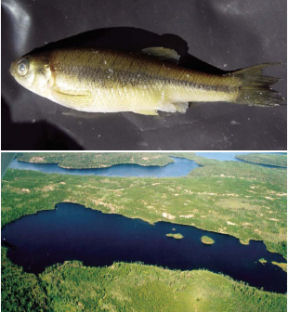- More than 2 years ago
Trace amounts of natural and synthetic estrogens released into the environment by wastewater-treatment plants are known to cause reproductive abnormalities in fish. Researchers have now found an even more dramatic consequence of exposure to the synthetic estrogen used in birth control pills—the near extinction of a fish population.

Women taking birth control pills excrete the synthetic estrogen 17alpha-ethynylestradiol along with natural estrogens. Male fish exposed to estrogens at concentrations of only a few parts per trillion (ppt) can become intersexual, displaying male and female tissues in their gonads (SN: 3/10/07, p. 152).
“A big question remained,” says Karen A. Kidd, an ecotoxicologist at the University of New Brunswick in Canada. “Can these males still successfully reproduce, or are fish populations at risk?”
In 1999, Kidd, then at Fisheries and Oceans Canada in Manitoba, and her colleagues began a study at the Experimental Lakes Area, a facility in northwestern Ontario set aside for whole-lake experiments. For 2 years, the team gathered data on species in one study lake and in two reference lakes. During the summers of 2001 through 2003, the researchers added 17alpha-ethynylestradiol to the study lake three times per week, maintaining a concentration of 5 to 6 ppt.
The researchers focused on a common species of fish, the fathead minnow, which they collected from the lakes at regular intervals from 1999 through 2005. They examined changes to its reproductive system and monitored its population.
By the spring of 2002, the scientists observed delayed sexual development of all the males collected. A year later, some males also had early-stage eggs in their testes. “These are all the responses we expect to see, based on what’s been found in other studies,” says Kidd.
But beyond those effects, as the researchers report in the May 22 Proceedings of the National Academy of Sciences, the number of fathead minnows in the lake plummeted. The estimated fish population dropped by a factor of a thousand from 1999 to 2005. “By the end of the seventh year, only a handful of fathead minnow were left,” says Kidd.
Aquatic ecotoxicologist Susan Jobling of Brunel University in Uxbridge, England says that to be clearly environmentally relevant, the study’s estrogen concentration would have to be “a little bit lower.” Recent studies pin the concentration of 17alpha-ethynylestradiol in the environment to less than 1 ppt, she says, but “that doesn’t take away from the importance of the study, that population level effects have been demonstrated.”
David L. Sedlak, an environmental chemist at the University of California, Berkeley, agrees that it’s an “elegant and useful study,” even though the estrogen concentration was on the high side. For waterways that receive most of their flow from sewage-treatment plants, improvements in technology would help. “This is a problem that can be solved with treatment,” he says.






